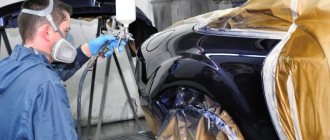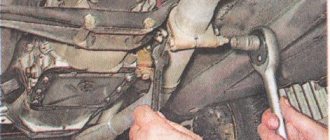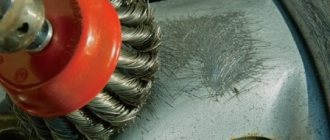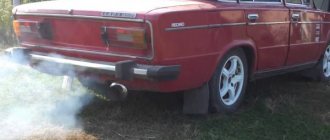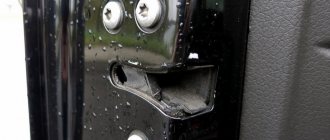Protect your car muffler from corrosion
To increase the service life of the exhaust pipe, car enthusiasts use two main methods:
- Drilling a hole in a pipe to allow condensate to drain out.
- Application of heat-resistant paint.
The first method allows condensation to escape, thereby preventing the accumulation of liquid and the formation of rust. Despite its effectiveness, not all motorists are ready for such radical interventions.
So, painting a car muffler with special paint to prevent it from rusting is often the only way to combat corrosion. This protects against rust and prevents accelerated aging of the metal from high temperatures. The best option is to paint the calipers with silver enamel: this is a reliable method, moreover, it is pleasant and affordable.
Muffler painting instructions
Before painting a car muffler, to prevent the assembly from rusting, you must thoroughly clean the surface of the old coating. This is a mandatory stage on which the strength and reliability of the subsequent coating, effective protection against corrosion and wear depend. When painting the most important part of the exhaust system, special attention should be paid to the quality of its cleaning from rust, dirt and old coating. The heat-resistant composition ideally fits only on a well-prepared surface.
Preparation
For cleaning you can use: – a stiff brush with wire bristles; – chemical removers; – figured scraper; - heat gun. When using a brush with stiff wire bristles, rust can often be found under a layer of paint and dirt, the area of which must be additionally treated with epoxy putty. Chemical strippers can be used before applying heat-resistant (heat-resistant) spray paint to the muffler. These active substances are excellent for cleaning the surface of a part from old organic or water-soluble paints. They are applied in a thick, dense layer to the part. To do this, use a brush with natural bristles. Then the paint is removed using a spatula or wooden spatula. After this, the surface should be wiped dry with a clean rag or napkins. A shaped scraper is used when preparing an exhaust system element for painting. It's convenient to use. To achieve a perfectly smooth surface, it is necessary to sand using medium-grain sandpaper or a special machine. Heat-resistant spray paint for the muffler adheres well to a surface that has been cleaned of the old enamel layer using a heat gun. This tool must be used with extreme caution, observing fire safety regulations. To do this, it is recommended to place a piece of damp cloth under the part during heat treatment.
Important! A heat gun cannot be used if it is made with a large amount of lead. This chemical element evaporates when heated, so it can be harmful to health.
Painting
If you have already decided on how to paint the car muffler so that it does not rust, you can start painting. This stage has its own difficulties. During the process of painting the muffler, smudges often form. They can worsen the performance characteristics of the unit and do not look aesthetically pleasing at all. To prevent the formation of sagging, you must adhere to a simple technology: – the enamel must be applied in thin layers, each time after complete drying; – the spray gun should be held at the same distance from the surface; – do not move the sprayer at an angle or in an arc; – the sprayed substance should capture not only the edges of the part, but also extend beyond its boundaries; – each strip must be applied evenly to the previous painted areas.
Pay attention to: How to prepare a bumper for painting: step-by-step instructions for doing the work yourself
Heat treatment
After coating, the surface needs additional heat treatment. The easiest way to do this is with a hair dryer. In order for a truly heat-resistant coating to form during the drying process, it is necessary to periodically pass hot air through the part in both directions. Some experts also advise pre-heating the outer part of the exhaust manifold. However, some motorists believe that this stage is not mandatory. According to them, the muffler heats up during the operation of the equipment, so it does not require additional calcination.
Is it allowed to paint the muffler on a car?
Whether to paint the exhaust pipe is up to you. The factory paint, which is mainly responsible for its presentable appearance, begins to lose its integrity soon after purchasing the car. In addition, scratches are possible already during installation, and welding work reduces the protective characteristics of the top layer.
Rusty car muffler
Although it is not covered with anything on the inside, when properly applied to protect the car muffler from corrosion on the outside, the paint still protects for some time, significantly extending the life of the part.
Painting the muffler extends the service life of the part
Read further:
How to paint a metal stove in a bathhouse?
Properties of heat-resistant paint: advantages and scope, types of compositions and coating technology
Do-it-yourself technology for painting chimneys: choosing paint and step-by-step instructions for painting from different materials
Painting a barbecue: features of paint selection and application technique.
Fire retardant paint: principle of operation and scope of application, types of paint for metal and wood, the best manufacturers
Please note: Thickness gauge: description of the device, rules and procedure for use
The vehicle exhaust system operates under difficult conditions. And often individual elements of this system fail after the first 3-5 years of car operation. The main cause of breakdowns is corrosion. Read below about how to paint a car muffler to prevent it from rusting.
Selection of paint for a car muffler
Choose paint for the muffler based on the following basic parameters:
- Heat resistance (the higher the better: the exhaust pipe can heat up to 600 degrees, so its temperature range should be from -35 to 600 degrees Celsius).
- Anti-corrosion.
- Waterproof.
- Painting characteristics: structural uniformity, color saturation, drying speed.
It is best to buy silicone enamel or heat-resistant varnish.
Heat resistant
Silicone heat-resistant paints are popular among car enthusiasts because they are easy to use (applied in several layers and do not require a primer).
Painting a car muffler with a heat-resistant compound not only protects against rust, mechanical damage and chemicals, but also extends the life of the exhaust pipe, making it resistant to high temperatures.
Heat resistant paint for muffler
There is an important point that distinguishes heat-resistant paint for the muffler: in order for it to harden, the composition must be heated to 160–200 degrees. This can be done using a hair dryer or high temperature oven. The drying period for each layer is 15–20 minutes.
Fireproof
Painting a car muffler with fire-resistant powder paints, as a rule, takes place in an industrial environment. The composition, in comparison with silicone heat-resistant analogues, makes it possible to withstand higher temperatures. The main disadvantage is the difficulty of application.
Serebryanka
The best paint for a car muffler is silver. At service stations, it is most often made silver or black: these shades can withstand temperatures of up to 600 degrees in the short term, and up to 400 degrees in the long term. Other colors are less heat resistant.
Choosing heat-resistant paint for a car muffler
Anti-corrosion muffler paint is commonly used in automobile manufacturing. It protects the metal from rust for some time. However, during operation of the exhaust system, the factory coating quickly burns, so the element needs to be painted again. How to treat a part to extend its service life? Since the exhaust manifold can heat up to 700-800 °C during vehicle operation, it needs to be painted only with paintwork that will ensure high thermal and corrosion resistance of the part. For these purposes, it is recommended to use heat-resistant silicone enamel. One-component paintwork materials are intended for application to surfaces that during operation are exposed to extremely low or high temperatures: from – 60 °C to + 600 °C. Painting the muffler with organic enamel containing silicon protects the part from corrosion and helps increase the service life of the exhaust manifold. The composition of paints and varnishes contains special additives, which ensure excellent painting and technological properties. There is no need to prime the surface to be treated before applying silicone enamel. The muffler coated with high-temperature paint is resistant to salt fog, gasoline, oils and moisture, and sudden changes in temperature. Enamel is well transported. During storage it does not lose its original properties. It can be easily applied to a previously prepared surface using a brush or roller, sprayed using pneumatic or airless spraying. It is not destroyed by exposure to high temperatures. The strength indicators of the exhaust manifold, on the contrary, are improving. It is possible to coat the muffler with silicone enamel even at subzero temperatures. The main condition is that the paint must be applied in several layers, each time after complete drying at a temperature of 160 to 200 ° C. A hair dryer or drying cabinet is suitable for heat treatment. Painting the muffler with heat-resistant paint is a process that requires following the instructions. If used incorrectly, paintwork materials will not provide the expected effect.
Pay attention to: How to prepare your car for painting yourself
Thermovarnish treatment
Another proven method of anti-corrosion protection of a muffler is to use a special thermovarnish. We are talking about a type of coating that is particularly resistant to high temperatures, preventing the appearance and further spread of rust spots.
At the same time, it is strongly recommended to use such a product even after drilling a hole in the muffler compartment, since the walls of the drilled hole are subject to corrosion much more than any other parts of the body, without galvanizing or any other protective coating.
If, by the time of treatment, the external elements have already undergone corrosive changes, then before applying the thermovarnish, an appropriate preparation procedure will have to be carried out.
To do this, it is recommended to use a special abrasive tool for cars - a brush, with which you can relatively easily remove rust while simultaneously sanding the surface. This is also necessary to ensure maximum effective adhesion to the new material.
Staining order
Painting a muffler consists of three main stages:
- preparation of metal elements;
- painting of auto parts;
- baking paint.
Preparatory work
Preparation stages:
- using a pneumatic sandblasting sprayer, clean the surface from dirt;
- dry the exhaust system;
- treat the metal with a rust converter;
- remove rust residues;
- using a chemical solvent, remove oil and various stains;
- sand the surface with sandpaper;
- wipe the surface with acetone;
- apply primer (only for silicone paints).
Muffler painting
The method of painting the exhaust system and muffler depends on the chosen paint material:
- Silicone. The paint is applied to the surface using a brush, roller or spray gun. Spare parts are painted in 1-2 layers, maintaining the drying interval specified in the instructions for each.
- Powder. To apply powder to auto parts, an electrostatic gun is used (for applying powder paint). A charge must be applied to the surface that is going to be painted.
- Aerosol. The spray is shaken and sprayed over the auto part from a distance of 20-30 centimeters. It is recommended to apply 2-3 layers of paint. The interlayer exposure should be 5-30 minutes (depending on the manufacturer’s recommendations).
Design and dimensions of paint booths for cars, their types and operating principles
Heat treatment
After painting, it is recommended to heat the painted surface of the muffler. Spare parts must be baked in a special oven. Infrared lamps can be used to heat the painted exhaust system. The main thing is to bake the object at a temperature of 180-200 degrees Celsius for 10-15 minutes.
During the heating process, the coating undergoes polymerization and hardening. It is not recommended to use a cooking oven for baking auto parts.


